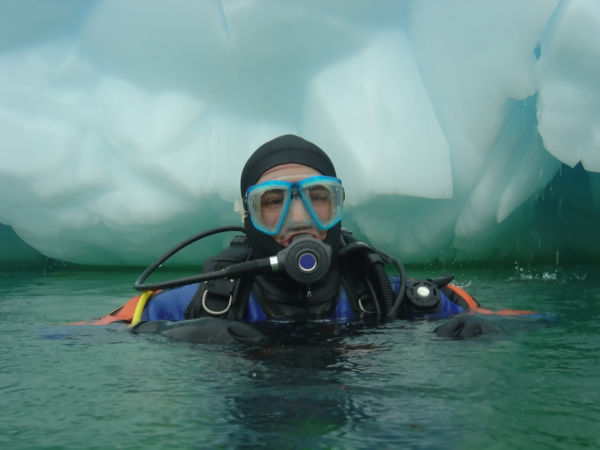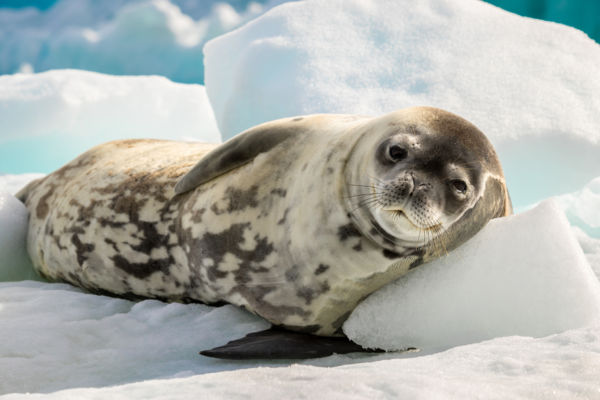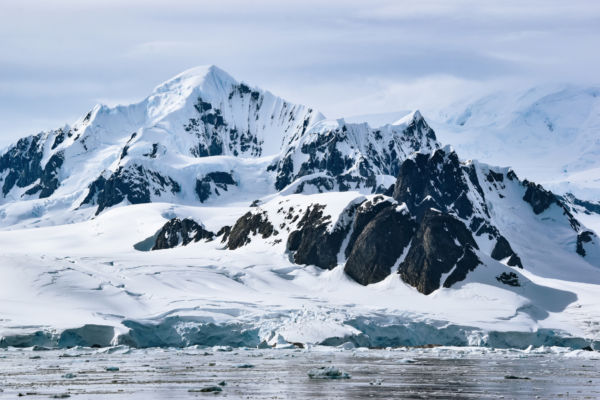Scuba diving in Antarctica means diving somewhere that very few have ever visited, let alone been fortunate enough to dive. Aside from abundant marine life, the lure of diving in Antarctica is the fantastic sight of shifting sunlight and ice formations. Only about 1% of light makes it through the ice, creating an ethereal world of hills, valleys and sheer cliffs all made of ice and all quietly waiting to be explored underneath a glowing blue sea.

What can you see?

Scuba diving in Antarctica offers plenty to see, with lots of biodiversity. Antarctic waters hold an abundance of krill, which attracts other marine life. Divers can see:
- Unique varieties of kelp, including kelp walls
- Sea snails
- Jellyfish
- Sea butterflies
- Starfish
- Sea-hedgehogs (urchins)
- A variety of crabs
- Anemones
- Soft coral
- Sea squirts
- Squat lobsters
- Peacock worms
- Dogfish
- Shrubby horse-tails
Divers may also see some of the charismatic animals the continent is so famous for—fur seals, penguins, and leopard seals. Walrus spotting is best done from the boat or with snorkel gear—diving with them is ill-advised as they can get aggressive.
Dive qualification and experience
Diving in Antarctica is not for beginners. Divers must have experience with cold-water diving and at least 30 dives with a drysuit. Further, you will have to present your internationally recognized dive qualification, copies of your dive logs, and a medical clearance before you can get into the water. Divers must also do a check-dive to get used to the cold water and establish how many weights they need.
Risks of scuba diving in Antarctica

Scuba diving inherently involves some risks. That said, there are a few additional things to consider when planning your diving in Antarctica.
The dive sites are remote, and decompression chambers are far away. Divers are cautioned against deep dives.
Divers should be aware of and always stay oriented to safe exit points during their dives. Ice continually moves and shifts, and thus entry and exit points could move along with it.
Equipment
Diving in Antarctica requires specialized equipment. This includes an extensive list:
- A drysuit with a hood and two sets of thick undergarments
- Dry gloves or thick wet gloves
- Two sets of freeze-protected or environmentally sealed regulators. This includes first and second stages. Some dive concessions use two regulators on one tank. One set will be your primary, with the second set as a back-up on each dive.
- A quick-release BCD
- Depth gauge plus a watch or computer
- Compass
- Air-pressure gauge—one for each regulator set-up
- Knife
- A flashlight
- Mask, fins, and a snorkel. A spare mask and straps are recommended.
- Weight belt—the weights are provided onboard.
- Spare parts, including spares for your regulator and drysuit
- Commercial defogging agents for your mask. Spit can freeze onto the inside of your mask.
When to go
The dive season is in the southern summer, between November and March. This is when wildlife is most active.
During November and December, phytoplankton burst to life in areas where there are mineral upwellings. This brings in masses of krill, which then brings in larger marine animals. During this time, you could see crabeater seals, elephant seals, humpback, minke, and southern right whales, and penguins. In December, you can witness the midnight sun above water.
During February and March, divers could see fur seals and leopard seals and penguins. Whale watching is especially excellent during this time, and there is the chance to see the Aurora Australis and green and pink algae blooms on the ice cliffs and snow slopes.
Diving conditions
The water temperature averages a frigid 28 to 36 F (-2 to 2 C) and visibility can be up to 985 feet (300 m). The average maximum dive depth is around 60 feet (20 m), and dives are done from shore or off a zodiac, including shallow ice diving and wall diving. Divers usually do two dives per day, depending on the weather and ice conditions.
Most dives in Antarctica are based on the buddy system. Dive guides generally stay on the boat, acting as spotters and checking divers in and out of the water.
Getting there
Most expeditions to Antarctica depart from the southernmost city in the world, Ushuaia, Tierra del Fuego in Argentina.
Scuba diving in Antarctica is more an expedition than a dive trip. The conditions are far removed from tropical diving, but it is also an experience that few will ever have. The cold water and clear visibility, along with abundant marine life and the sheer adventure of getting there make for a truly once-in-a-lifetime trip.


